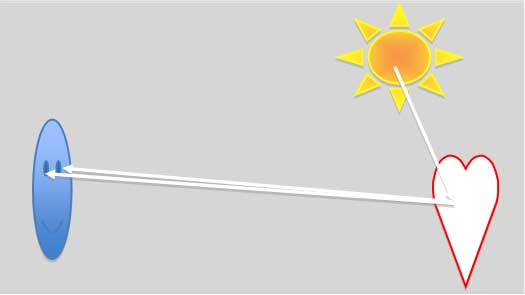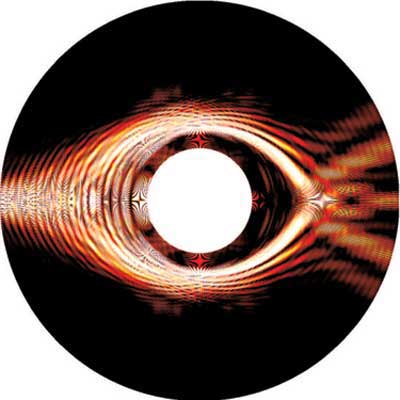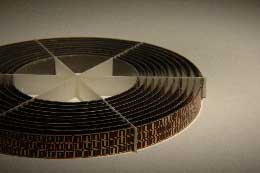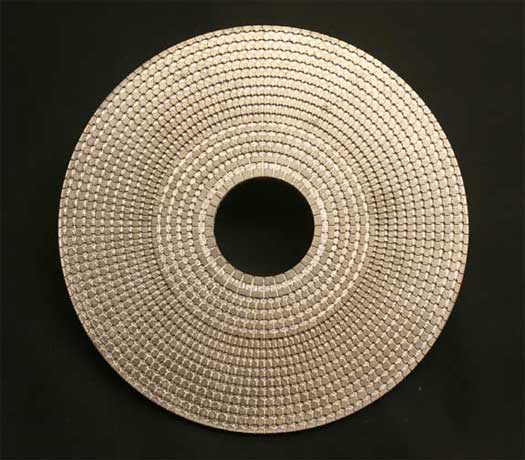Cloaking – Making Something Appear Invisible
Science fiction movies have often used devices that make objects invisible. In Star Trek the Klingons and Romulans used cloaking devices for their starships. Harry Potter had the invisibility cloak. Current scientific endeavors have something a bit more realistic.
Why something appears invisible
Making something appear invisible means that your eyes (or some detector) can’t detect it. Consider what it takes to see something. When you see things, light from the object you are viewing enters your eyes and interacts with the rods and cones in your eyes. This interaction results in an electrical impulse being sent to your brain and you perceive something. The color the object appears depends on the frequency of the light entering your eyes, the “hardware” in your eyes (cones), and what your brain does with this information. The rods only detect black and white, while the cones detect color. A black object appears black because it is absorbing the light, which is detectable to our eyes – that is, the absence or reduction of light is detectable.

To see something, light from it must enter your eyes and interact with the hardware (rods and cones) in your eyes, which sends a signal to your brain and you perceive something.
For something to be invisible, all we need to do is make the light from an object not enter our eyes (a detector), and not get absorbed by the object. If all the light gets transmitted through the object, without scattering, then we don’t see it. If the light gets bent around the object rather than reflecting off of it or the light reflects off the object in such a way that it does not get into a detector, then we cannot see it. If the reflected light from the object enters our eyes but cannot be distinguished from the surrounding objects, then it is camouflaged and we cannot see it. In all these cases the object is invisible or cloaked. The ideal cloak has the light bend around the object so you can see what is directly on the other side of the object, without ever seeing the object in front of you.1 This idea doesn’t just apply to visible light, it applies to any electromagnetic wave and to acoustic waves too.2

A photonic crystal structure that illustrates cloaking where the light bends around the center. From the left, the beam begins to diverge as it travels towards the center; it then bends around the cloaked object and re-forms as another beam on the opposite side. Image courtesy of Yaroslav A. Urzhumov and David R. Smith, Phys. Rev. Lett. 105, 163901 (2010)
Trying to make something invisible to a detector is not new. The stealth bomber designed and built in the 1980’s is nearly invisible to radar and also has reduced, infrared, visual, and acoustic detection.3 Clearly this plane is far from invisible to the eye when it is nearby on a sunny day. Different frequencies have different interactions with objects, making it difficult to make something invisible for all types of electromagnetic waves. However, even on a sunny day the stealth bomber’s radar signature is less than 1/10 of a square meter!3

The B-2 bomber appears to be less than 1/10 of a square meter when detected by radar.

The actual dimensions of a B-2 bomber with a wingspan of 52.4 m and surface area of more than 1000 square meters.

A square meter, scaled down. A meter is about the length of a leg of someone who is 5’6” tall. 1/10 of a square meter is shaded in purple.
Scientific progress
Physicists, engineers, and mathematicians are all working together to find special materials that will interact with electromagnetic waves in such a way that they bend around the object. These materials are called metamaterials and they may not be what you expect. Meta was originally picked to mean transcend or go beyond, but meta also means a more highly organized or specialized form. Metamaterials both transcend regular materials and are more highly organized with a special form or structure, so you may find references to both meanings. A metamaterial usually consists of a highly conducting metal (for example gold or copper), formed in small shapes and arranged in a special structure. For example, it might be little split rings outlined in copper that are next to each other in rows and are arranged on a sheet four rings high. Then this sheet may be wrapped into a cylinder. Having many of these sheets forming concentric cylinders might look something like the image below. This is a metamaterial. The highly conducting material is important, but the arrangement of the material is essential to create the cloaking properties.4
 (a) |
 (b) |
 (c) |
|
Rectangular rings of copper with a split in them, known as split-ring resonators, placed in a pattern on a substrate. (a) the substrate is a fiber composite circuit board material called FR4. (b) The substrate is Teflon based material called duroid. (c) A graph showing cloaking. Images courtesy of David R. Smith, Duke University.
These specially arranged structures can lead to an effective index of refraction that is negative. Most materials have a positive index of refraction and this characteristic determines how light will bend when it interacts with the material. The index of refraction for electromagnetic waves is defined as the speed of a light in vacuum to the phase speed (how fast the top of the wave travels) in the material of interest. This ratio is based on how the charged particles in atoms making the material interact with electromagnetic waves.
To create invisibility, the cloaking device (metamaterial) needs to bend the electromagnetic waves around itself and the object it is cloaking. This requires that no distortions of the light waves (electromagnetic waves) due to the cloaking device are detected. This is certainly not science fiction nor is it magic. Scientists have already created cloaking devices that work for certain ranges of the electromagnetic spectrum, for example, microwaves, infrared light, and some acoustic waves.

Image of a metamaterial whose structure allows us to control acoustic waves. It’s actual size is about the size of a computer or video disk.
Besides creating cloaking devices, these metamaterials may also help us to see things smaller than we ever thought we could. When a material has a negative index of refraction it could also act as a “superlens” which lowers the diffraction limits. Ordinary lenses are limited by diffraction. The best an ordinary lens can do is image an object greater than half the wavelength of light being used. A superlens would allow scientists to image objects smaller than half a wavelength.
References and Links
1. Science on MSNBC.com, Here’s how to make an invisibility cloak: Theoretical cloaking device that could soon become reality (sort of)
2. Physical Review Focus, How to Shout without Anyone Hearing, 1 April 2011, based on the Physical Review Letters article: Rotter, S., Ambichl, P., & Libisch, F., Generating Particlelike Scattering States in Wave Transport, Phys. Rev. Lett. 106, 120602, (25 March 2011).
3. wikipedia: Northrop Grumman B-2 Spirit
4. Science Daily, Science News, Next Generation Cloaking Device Demonstrated, Jan 16, 2009
5. Pendry, J, Taking the wraps off cloaking, Physics 2, 95 (2009)
6. Handwerk, B., Invisibility Cloak, Materials that Bend Light “Backward,” National Geographic News, 12 August 2008
7. How do ‘invisibility cloaks’ work?
8. The Research Group of David R. Smith, Duke University, Novel electromagnetic materials: Blueprint for invisibility.
9. Strain, D., Invisibility Crystals Make Small Objects Disappear, Wired Science, 2 February 2011.
—H.M. Doss














